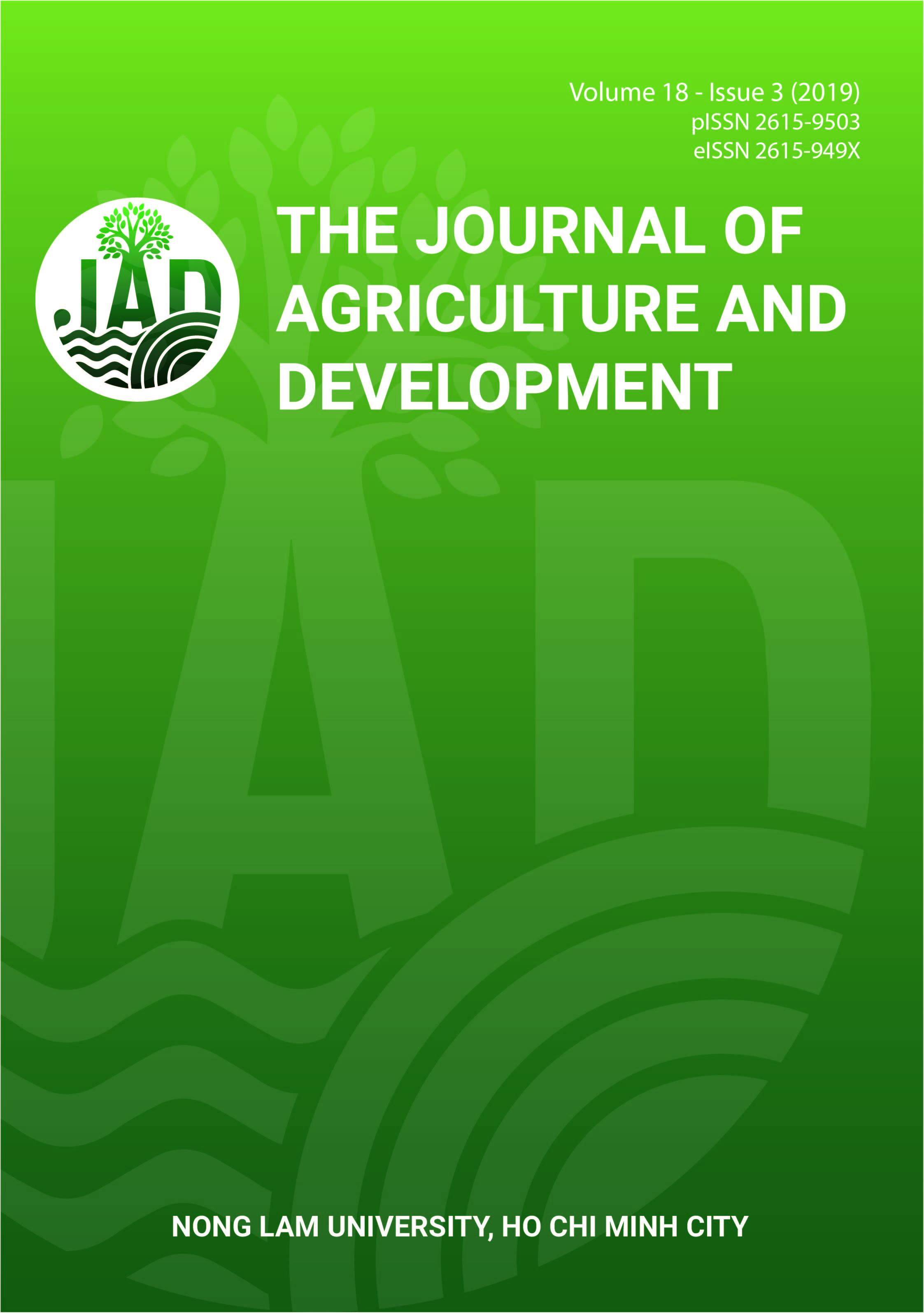Optimum condition of manufacturing hybrid particleboard from mixture of cocoa pod husk and bamboo particles
Main Article Content
Abstract
This study was to investigate the feasibility of using cocoa pod husks (CPH) and bamboo in manufacturing hybrid particle board. Three-layer experimental particle boards from mixture of bamboo and CPH participles were manufactured using different surface to core layer ratios (30, 40 and 50%) and various UF ratios for surface layer (6, 8 and 10%) and for core layer (4, 6 and 8%). Modulus of rupture (MOR), internal bond strength (IB) and thickness swelling (TS) properties of the boards were evaluated based on Standard TCVN7756:2007 Test Methods for general purpose used in dry conditions. The results showed that boards in all ratios of surface to core layer investigated could be manufactured using up till 8% UF resin for surface layer and up till 6% UF resin for core layer without falling below the minimum Standard VN7754:2007. The optimal condition was the surface to core layer ratio of 30% used with 9.51% UF resin for surface layer and 7.45% UF resin for core layer obtaining the lowest thickness swelling (TS) 11.13%. The highest values of MOR and IB were 15.25 MPa and 0.45 MPa, respectively. This study demonstrates that cocoa pod husks and bamboo waste can be an alternative raw material source for particleboard production.
Article Details
References
Abdul, H. J., Paridah, M. T., Adrian, C. Y. C., & Zaidon, A. (2014). Effect of Kenaf parts on the performance of single-Layer and three-layer particleboard made from Kenaf and Rubberwood. BioResources 9(1), 1401-1416. https://doi.org/10.15376/biores.9.1.1401-1416
Bowyer, J. L., & Stockman, V. E. (2001). Agricultural residues: an exciting bio-based raw material for the global panel industry. Forest Products Journal 51(1), 10–21.
Bui, A. V., Nguyen, Q. V., & Pham, M. T. T. (2010). Research on utilizing cashew nut cover and Eucallyptus urophylla chip for common particle board producing. Vietnam Journal Forest Science 3, 1383-1387.
Ciannamea, E. M., Stefani, P. M., & Ruseckaite, R. A. (2010). Medium-density particleboards from modified rice husks and soybean protein concentrate-based adhesives. Bioresource Technology 101(2), 818–825. https://doi.org/10.1016/j.biortech.2009.08.084
De, A. A. C., Victor, A., De, A., Elen, A. M. M., Maristela, G., Rafaele, A. M., Jos´e, N. G., & Juliana, C. B. (2017). Wood-bamboo particleboard: Mechanical properties. BioResources 12(4), 7784-7792. https://doi.org/10.15376/biores.12.4.7784-7792
Guler, C., Bektas, I., & Kala Y. H. (2006). Properties of particleboard from sunflower stalks (Helianthus annuus L.) and Calabrian pine (Pinus brutia Ten). Forest Products Journal 56, 56–60.
Guler, C., Halil,. (2016). The potential for using corn stalks as a raw material for production particleboard with industrial wood chips. Journal of Wood Research 61(2), 299-306.
Hamidreza, P., Abolghasem, K., & Taghi, T. (2012). The potential for using walnut (Juglans regia L.) shell as a raw material for wood-based particleboard manufacturing. Composites: Part B 43(8), 3276–3280. https://doi.org/10.1016/j.compositesb.2012.02.016
Hoang, H. T. (2002). Study on producing board from combining Balcooa bamboo and Rubber wood (Unpublished doctoral dissertation). Vietnamese Academy of Forest Sciences, Ha Noi, Vietnam.
Li, X., Cai, Z., Winandy, J. E., & Basta, A. H. (2010). Selected properties of particleboard panels manufactured from rice straws of different geometries. Bioresource Technology 101(12), 4662–4666. https://doi.org/10.1016/j.biortech.2010.01.053
Nurhazwani, O., Jawaid, M., Paridah, M. T., Abdul, J. H., & Hamid, S. A. (2016). Hybrid particleboard made from bamboo (Dendrocalamus asper) veneer and Rubber wood (Hevea brasinesis). BioResources 11(1), 306-323.
Pham, N. N. (2010). Study on the production process parameters of particle board from agricultural residues. Journal of Forestry Science and Technology 1, 78-82.
Rowell, R. M, Anand, R., Claufield, F. D, & Jacobson, E. R. (1997). Utilization of natural fibers in plastic composites, problems and opportunities. Journal of Thermoplastic Composites Materials 15(4), 281-300.
Tran, C. V. (2012). Study on producing particle board from Rubber wood and Jatropha shells. Journal of Forestry Science and Technology 1, 88-95.
Vancai, L. (2010) Physical and mechanical properties of particleboard from bamboo waste. World Academy of Science, Engineering and Technology 4(4), 276-280.
Oh, Y. S., & Yoo, J. Y. (2011). Properties of particleboard made from chili pepper stalks. Journal of Tropical Forest Science 23(4), 473–477.








